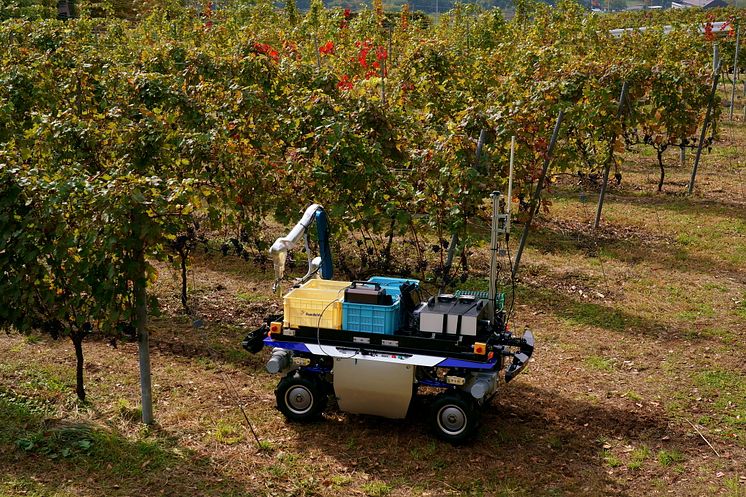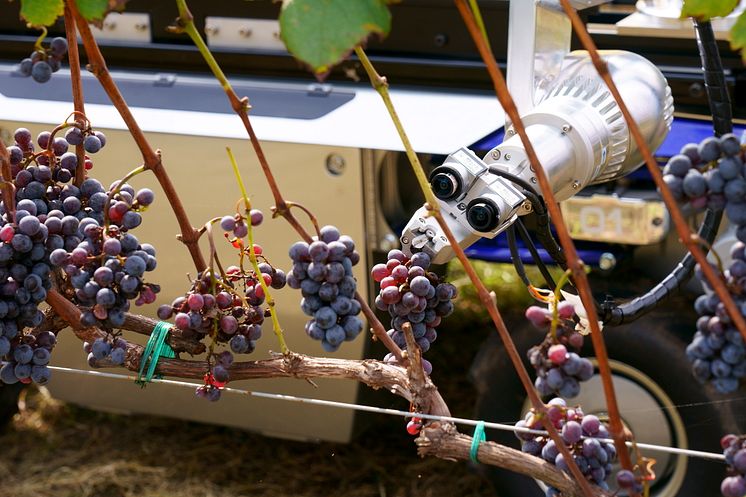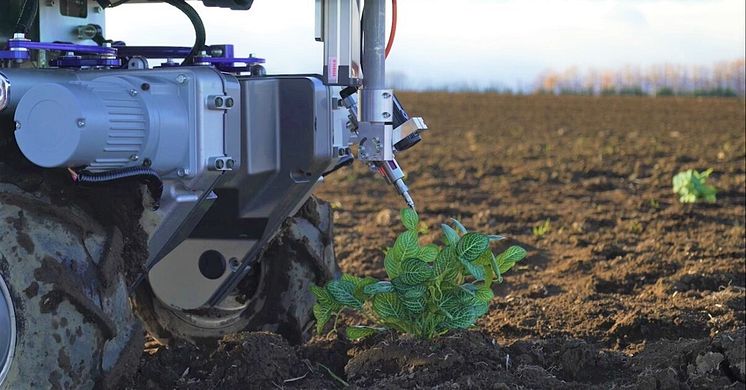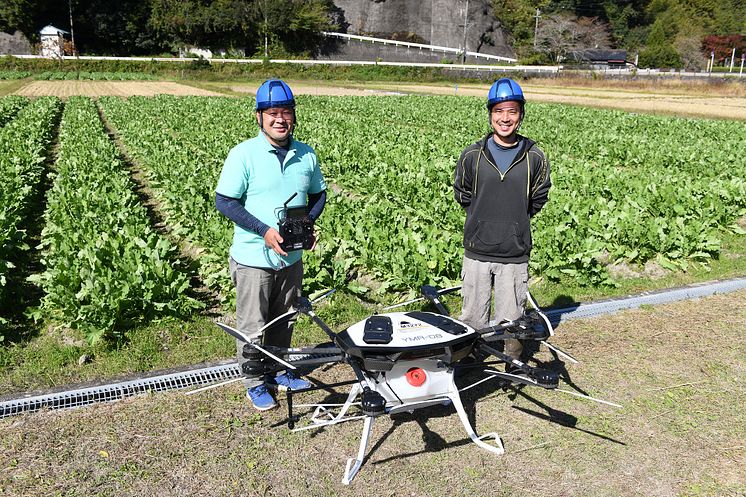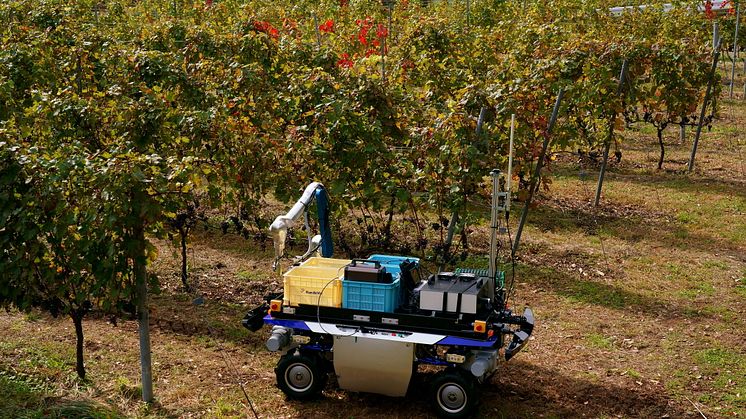
News -
Solving Societal Issues with Unmanned Solutions Yamaha Motor Newsletter (Feb. 8, 2021 No. 84)
Today, Yamaha Motor is actively developing unmanned solutions to address a range of societal issues. Our strengths in this field stem from the record of results we forged from engaging in the personal mobility business as well as robotics from the late 1970s, and the considerable technological know-how acquired along the way.
At present, the labor shortages seen in the agricultural sectors of developed countries continue to grow more severe, and Yamaha is striving to combat this with highly versatile unmanned ground vehicles (UGVs) to help automate tasks and save labor.
In this issue, we introduce one UGV under development and touch on its progress.
Advantages in Bringing Robotics and Mobility Together

After sensing and avoiding obstacles, the UGV’s end effector carefully harvests the grapes.
As the unmanned ground vehicle (UGV) grips and cuts a ripe bunch of grapes from the vine, it almost looks like an adorable little animal looking to take a nibble. This field test to harvest grapes was held in a vineyard in one of Japan’s foremost wine-producing regions—Nagano Prefecture. Yamaha is working to create highly versatile unmanned vehicles that can bring greater automation and labor savings to agriculture, and the goal of the test that day was to have a UGV mounting an articulated robot arm automatically harvest and transport grapes from the vineyard.

Kei Nishimura leads the business development and promotion of the UGV project
“To bring this robotics technology to outdoor fields, both mobility and robotics technologies are necessary, and we recognize that Yamaha is one of the few companies in the world that has both, and we strongly believe that we can do a lot, that we can contribute a lot to this space,” says project leader Kei Nishimura. He heads the business development and promotion side of the project and also led research and development for MOTOBOT, Yamaha’s autonomous motorcycle-riding humanoid robot first unveiled in 2015.
The agriculture industry in developed countries across the world is facing an acute labor shortage that continues to worsen. “In the current system, the robot automatically moves to individual working points that our staff have set by GPS in advance,” continues Nishimura. “In the near future, we plan to add in AI technology so the vehicle can recognize its own surroundings, autonomously decide on and drive on its own path. The system we’re developing is intended for semi-natural environments like farmland, but it’s not limited to that. It would also work well in other industries that support peoples’ daily lives, like forestry and fishery, not just agriculture.”
Heading to the U.S. to Accelerate Development in 2021

System under development to remove potatoes missed during harvesting via remote operation
As Yamaha develops these highly versatile agricultural UGVs, the reason the project’s focus has been on grape harvesting and transport is that the technical difficulties involved are higher than what would be required for other crops. In order to first detect the position and number of grapes and then get the end effector close enough to the correct vine for harvesting, the UGV’s robot arm has to avoid a complicated assortment of branches and other obstacles that may be in the way. Deep learning is being used to overcome these challenges one by one, with the goal of seeing the UGV used in a wide range of fields in the future.
For example, in Hokkaido—Japan’s top-producing region of potatoes—the UGV is being tested for removing “volunteer potatoes.” These are small potatoes that were missed during the previous harvest that can grow into weeds over the course of the winter, and removing them every summer is a major undertaking for potato producers. The development team is aiming for a system that will allow producers to stay indoors and remove these leftover potatoes remotely. The combination of remote operation with automated movement is how Yamaha looks to find a direct solution to reducing labor.
“This year, we are going to ship this agricultural UGV prototype [for grape harvesting] to the United States and continue development there,” explains Nishimura. “At the same time, we want to find and collaborate with partners bringing a variety of expertise to the table to accelerate development.”
*Open the video at the bottom of this page to see the UGV in action and get an overview of this challenge.
Solving Small-Scale Farming Issues with Cutting-Edge Tech

Running field tests with drones and the like to examine labor-saving methods in agriculture
Yamaha’s work to modernize agriculture is not limited to UGVs; our industrial-use unmanned helicopters have long been an integral part of agriculture in Japan. In recent years, industrial-use multi-rotor drones have been gaining attention in the farming industry for their wide-ranging flexibility, whether it is spraying agrichemicals or surveying crop growth.
The farmers in the above photo are involved in a Small and Smart Farming proof-of-concept project being conducted in Japan. “In small farming villages in the mountains like this, there aren’t enough hands to tend the fields, so a lot of them have become ruined due to neglect,” says one participant. The project is raising high expectations to effect change in this space. “If we can reduce the labor load with smart agriculture, younger people like us can revitalize these abandoned fields. Smart agriculture uses robotics and telecommunications, and is exactly what small farming villages like this need.”
Grape Harvesting Field Test with Agricultural UGV Prototype
The Story Behind MOTOBOT
|
Message from the Editor Our Long-Term Vision toward 2030 is “ART for Human Possibilities,” and we’re working to address several societal issues as we carry out our growth strategies. Robotics forms the foundation of these strategies, and by combining robotics and mobility in incredible ways only Yamaha can, we hope you look forward to the new value the resulting creations will bring. Maiko Kawai |


